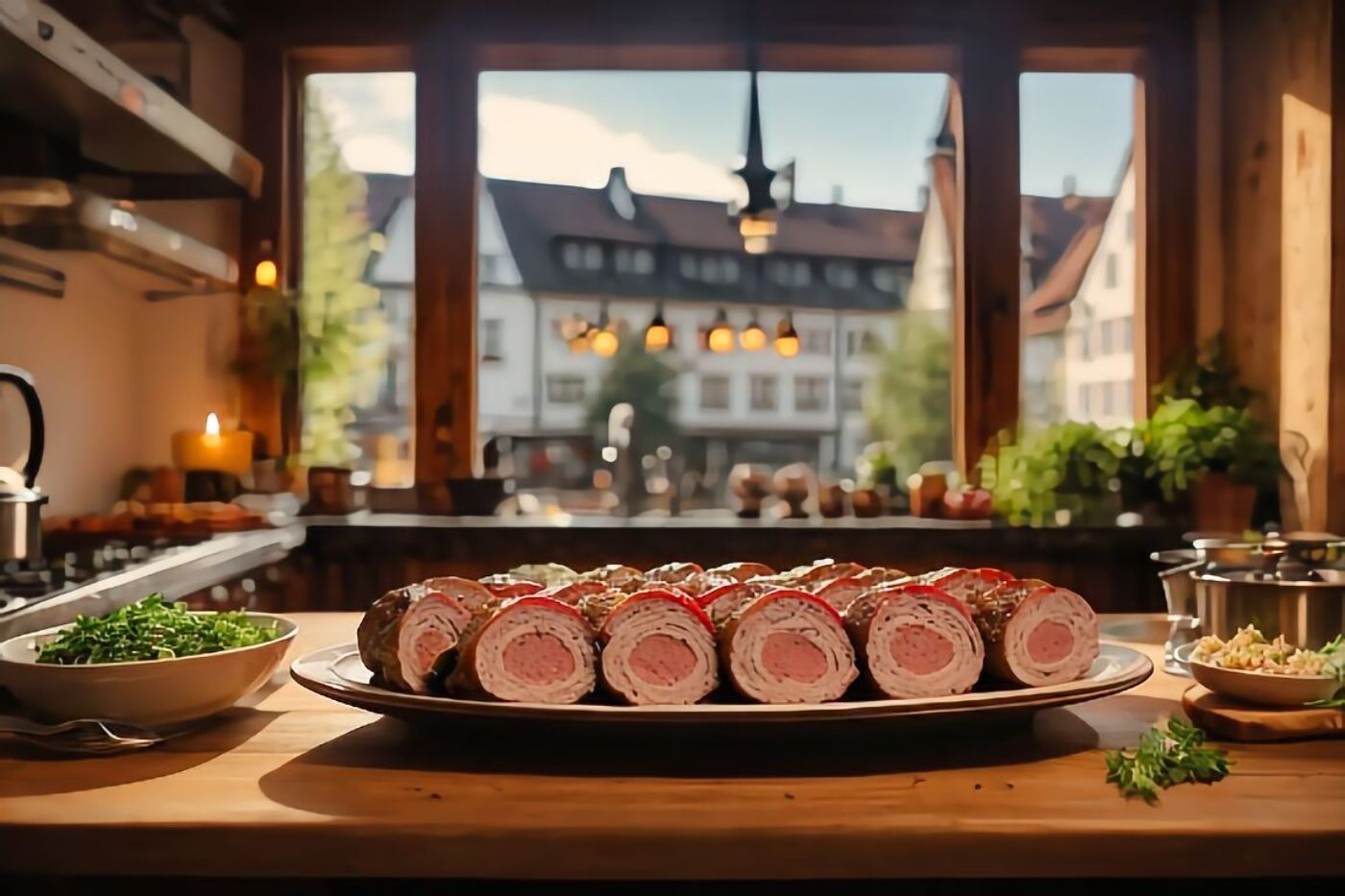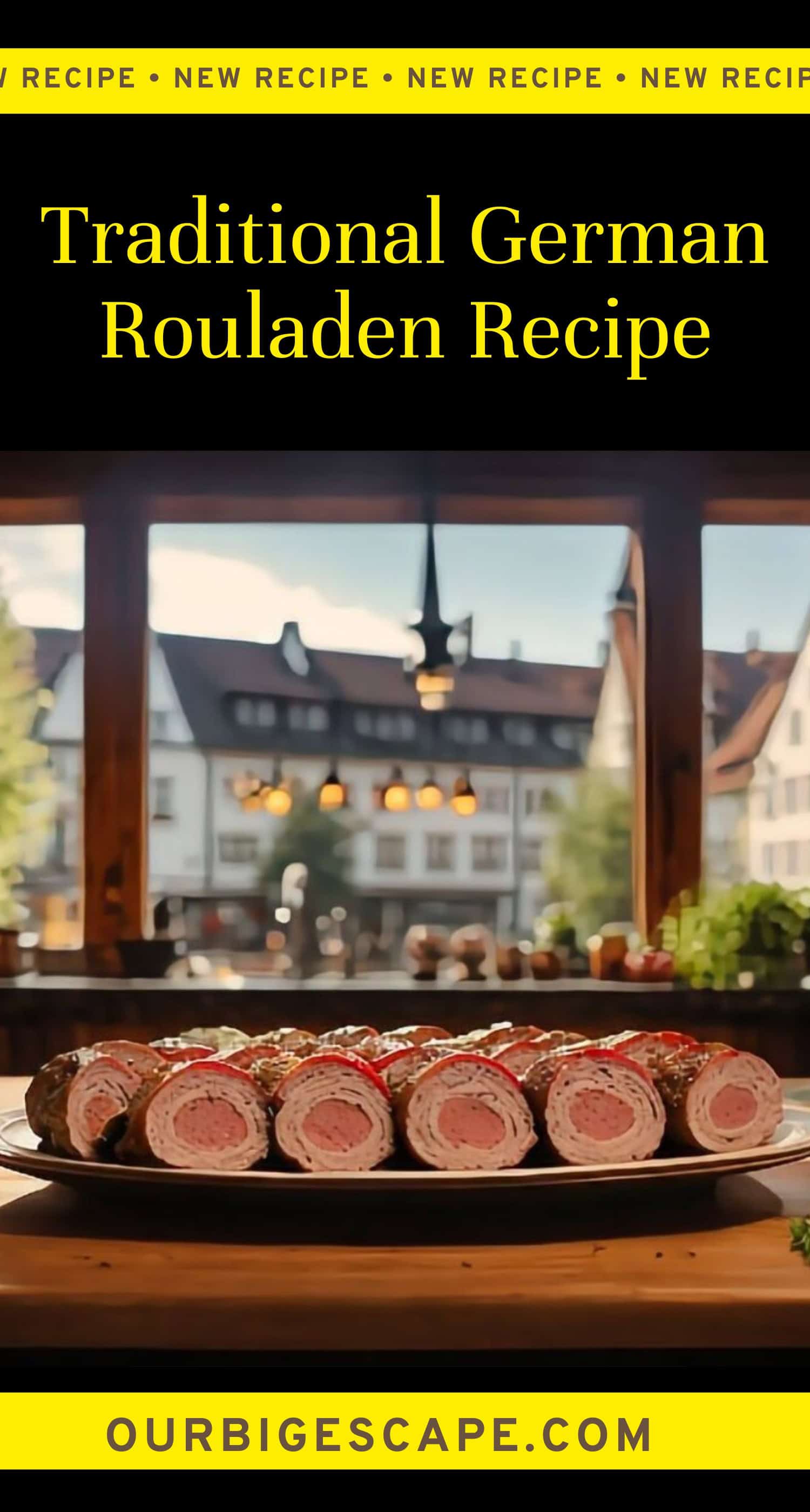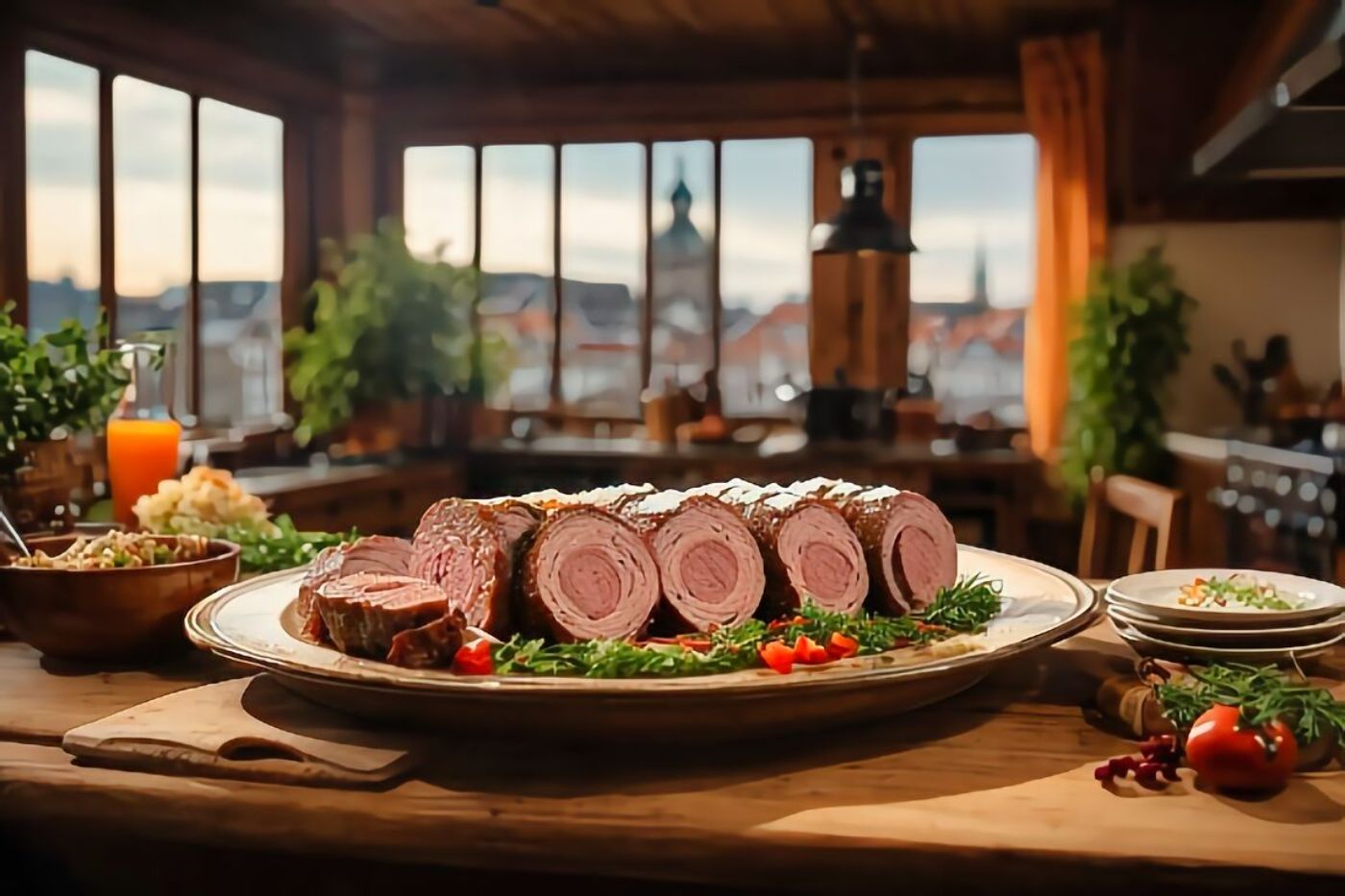
The German Rouladen Recipe is a traditional dish that consists of thinly sliced beef, typically beef round or flank steak, which is rolled up with various fillings. These fillings often include mustard, onions, and pickles. The rolled-up beef is then seared and braised until tender in a rich gravy made from the cooking juices. This dish is known for its savory and hearty flavors, and it is often served with sides like red cabbage and mashed potatoes.
German Food History:
Germany has a rich culinary history that dates back centuries. The country’s food culture has been influenced by various regions and historical periods. In the past, German cuisine was heavily based on locally available ingredients and preserved foods due to the long, cold winters. Cabbage, potatoes, and various meats like pork and beef were staples of the German diet.
Want more ideas for Your German Recipe Box?
A lot of great options are in these posts!
24 Traditional German Recipes/a>
You May Want to Join The World Recipes With Our Big Escape
Share your own recipes in our Facebook Group. Find recipes from all over the world. Learn more about International Cuisine and how you can surprise your family with new and exciting foods from all over the world.
For More Photos Visit Our Instagram at World Recipes Daily
Modern Food vs Historic Food:
Historically, German cuisine was characterized by simple and hearty dishes, often with a focus on practicality and preservation. Fermentation techniques were used to create foods like sauerkraut and pickles, which could be stored for extended periods. Potatoes, introduced to Germany in the 18th century, became a significant part of the diet.
In contrast, modern German cuisine has evolved to incorporate a wider range of ingredients and international influences. With increased access to global ingredients, German dishes have become more diverse. There is also a growing emphasis on healthy eating, with a focus on fresh produce and lean proteins. Convenience foods have gained popularity as well, reflecting changing lifestyles and the demands of contemporary society.
German Rouladen Recipe Health Benefits:
The German Rouladen Recipe offers several health benefits when prepared and consumed in moderation. Beef, the primary protein source in Rouladen, is a good source of essential nutrients such as protein, iron, and zinc. These nutrients play important roles in maintaining muscle health and overall well-being.
Additionally, the inclusion of pickles in the recipe can provide a dose of probiotics, which can benefit digestive health. Mustard, another common ingredient, contains antioxidants and can add a flavorful kick to the dish without excessive calories.
However, it’s essential to note that Rouladen is often served with rich gravy, which can be high in saturated fat and sodium. Therefore, portion control and moderation are key when enjoying this traditional German dish as part of a balanced diet.
In summary, the German Rouladen Recipe is a classic German dish known for its flavorful combination of beef and fillings, cooked to tender perfection in a rich gravy. This dish reflects the historical roots of German cuisine, which emphasized practicality and locally sourced ingredients. While modern German cuisine has evolved to incorporate a wider range of foods, traditional dishes like Rouladen continue to hold a special place in the hearts and kitchens of many. When prepared thoughtfully and enjoyed in moderation, the German Rouladen Recipe can offer a satisfying and nutritious dining experience.

How To Make Our German Rouladen Recipe
Ingredients (8 Servings)
Rouladen
6 slices top round steak or flank steak (ca. 200g / 7 oz.) each)
3 tbsp dijon mustard or yellow mustard
6 slices prosciutto or 12 strips bacon
6 large dill pickles, cut into long spears
2 yellow onions, sliced
small bunch of fresh parsley, finely diced
2 tbsp plain or all-purpose flour
1 Ttbsp butter
1 Ttbsp oil
Sauce
1 tbsp butter
2 carrots, cubed
2 parsnips, cubed
¼ head of celeriac, cubed
½ a small leek, sliced
1 Tbsp tomato paste
1 Tbsp sugar
2 cups red wine
1 1/2 cups beef stock
sea salt and black pepper
Instructions
1. Place the 6 slices of top round steak or flank steak on a clean work surface.
a. Ensure that the meat is pounded thin and even using a meat mallet.
b. Season each steak with a pinch of salt and black pepper.
c. Spread 1/2 tablespoon of dijon mustard or yellow mustard evenly on each steak.
d. Lay 1 slice of prosciutto or 2 strips of bacon on top of the mustard.
e. Place a long spear of dill pickle and some sliced onions on each steak.
f. Sprinkle finely diced fresh parsley over the fillings.
2. Carefully roll up each steak, securing the fillings inside.
a. Use toothpicks or kitchen twine to secure the rolls.
b. Ensure the rolls are tightly sealed to prevent fillings from falling out.
3. In a large skillet, heat 1 tablespoon of butter and 1 tablespoon of oil over medium-high heat.
a. Wait until the butter is melted and the oil is hot but not smoking.
b. You may need to work in batches to avoid overcrowding the pan.
4. Place the rolled-up steaks in the skillet and sear them until they are browned on all sides.
a. This should take approximately 2-3 minutes per side.
b. Make sure to turn the rolls using tongs for even browning.
5. Once the steaks are nicely browned, remove them from the skillet and set them aside.
a. Place them on a plate and cover with aluminum foil to keep warm.
6. In the same skillet, add 2 tablespoons of plain or all-purpose flour.
a. Stir continuously to create a roux until it turns golden brown.
b. This should take about 2-3 minutes.
7. Gradually add 1 cup of beef broth to the roux, stirring constantly to avoid lumps.
a. Continue to cook and stir until the gravy thickens.
b. This should take approximately 5-7 minutes.
8. Return the seared rouladen to the skillet with the gravy.
a. Ensure they are fully submerged in the gravy.
b. Reduce the heat to low, cover, and simmer for about 1 to 1.5 hours, or until the meat is tender.
9. Occasionally check and turn the rouladen in the simmering gravy to ensure even cooking.
a. Adjust the heat as needed to maintain a gentle simmer.
10. Once the rouladen are tender, remove them from the skillet.
a. Carefully remove the toothpicks or twine.
11. Serve the German Rouladen hot, sliced into rounds, and drizzled with the rich gravy.
a. Optionally, you can serve them with traditional sides like red cabbage and mashed potatoes.
Estimated Prep Time: 30 minutes
Estimated Cooking Time: 1.5 to 2 hours

Pots, Pans and Cooking Equipment Needed for The German Rouladen Recipe
Large skillet
Meat mallet
Tongs
Toothpicks or kitchen twine
Plate for searing
Aluminum foil for covering
Cutting board
Knife
Wooden spoon
Measuring cups and spoons
Gravy boat (optional)
Best Way to Store Leftovers From The German Rouladen Recipe
a. Transfer any leftover German Rouladen to an airtight container.
b. Store the container in the refrigerator.
c. Ensure that the leftovers are covered with the rich gravy to keep them moist.
d. Label the container with the date to track freshness.
e. Consume the leftovers within 2-3 days to enjoy them at their best.
f. Reheat leftovers gently in the microwave or on the stovetop, adding extra gravy if needed.
Tips and Tricks For Easier Creation
Pound the meat thinly and evenly for easier rolling.
Secure the rolls tightly to prevent fillings from falling out during cooking.
Use toothpicks or kitchen twine effectively to seal the rolls.
Maintain a gentle simmer while braising to keep the meat tender.
Check and turn the rouladen occasionally for even cooking.
Serve with traditional sides like red cabbage and mashed potatoes for an authentic experience.
Adjust the gravy thickness by adding more or less beef broth as needed.
Side Dishes and Desserts For the The German Rouladen Recipe
a. Red cabbage cooked with apples and vinegar.
b. Creamy mashed potatoes for a comforting pairing.
c. Buttered spaetzle, a classic German noodle dish.
d. Green beans sautéed with garlic and almonds.
e. Roasted root vegetables for a hearty accompaniment.
f. Potato dumplings, known as Kartoffelklöße in German.
g. Fresh sauerkraut, a tangy and traditional choice.
How To Serve the German Rouladen Recipe
a. Slice the cooked rouladen into rounds, showcasing the delicious fillings.
b. Arrange the slices on a serving platter.
c. Spoon some of the rich gravy over the sliced rouladen.
d. Serve hot alongside your choice of side dishes.
e. Optionally, garnish with fresh parsley for a pop of color.
f. Provide extra gravy in a gravy boat for guests to add as desired.
Dietary Substitution For The German Rouladen Recipe
1. Vegan Options for the German Rouladen Recipe:
a. Substitute top round steak or flank steak with portobello mushroom caps.
b. Replace dijon mustard or yellow mustard with vegan mustard alternatives.
c. Use vegan bacon or tempeh bacon instead of prosciutto or bacon.
d. Replace dill pickles with pickled cucumber slices.
e. Substitute butter with vegan margarine.
f. Use vegetable oil instead of oil.
2. Gluten-Free Options for the German Rouladen Recipe:
a. Ensure the mustard used is gluten-free.
b. Use gluten-free bacon or prosciutto.
c. Substitute all-purpose flour with gluten-free flour.
d. Choose gluten-free beef stock for the sauce.
e. Confirm the pickles are gluten-free.
3. Vegetarian Options for the German Rouladen Recipe:
a. Replace meat with extra slices of marinated and grilled tofu.
b. Use vegetable-based bacon or tempeh bacon.
c. Substitute butter with vegetable-based margarine.
d. Use vegetable stock instead of beef stock in the sauce.
e. Confirm that all ingredients are suitable for vegetarians.
4. Mediterranean Diet Options for the German Rouladen Recipe:
a. Use extra virgin olive oil in place of regular oil.
b. Serve with a side of Mediterranean quinoa salad.
c. Incorporate more fresh herbs like oregano and thyme.
d. Ensure the pickles are Mediterranean-style.
e. Use red wine with Mediterranean flavor profiles for the sauce.
5. Keto Diet Options for the German Rouladen Recipe:
a. Replace the flour with almond flour or coconut flour.
b. Choose nitrate-free bacon or prosciutto.
c. Use ghee instead of butter.
d. Serve with keto-friendly side dishes like cauliflower mash.
e. Ensure the wine used in the sauce is keto-approved.
6. Heart-Healthy Diet Options for the German Rouladen Recipe:
a. Use lean cuts of beef to reduce saturated fat.
b. Opt for turkey bacon or lean prosciutto.
c. Substitute butter with a heart-healthy oil like olive oil.
d. Choose low-sodium beef stock for the sauce.
e. Serve with steamed vegetables for a heart-healthy side.
7. Paleo Options for the German Rouladen Recipe:
a. Replace flour with almond flour or coconut flour.
b. Choose nitrate-free bacon or prosciutto.
c. Use ghee instead of butter.
d. Serve with paleo-friendly sides like roasted sweet potatoes.
e. Ensure the wine used in the sauce is paleo-approved.
8. Low Carb Options for the German Rouladen Recipe:
a. Replace flour with almond flour or coconut flour.
b. Choose nitrate-free bacon or prosciutto.
c. Use ghee instead of butter.
d. Serve with low-carb side dishes like cauliflower rice.
e. Ensure the wine used in the sauce is low in carbs.
9. Whole 30 Options for the German Rouladen Recipe:
a. Use compliant bacon or prosciutto.
b. Substitute all-purpose flour with almond flour or arrowroot powder.
c. Use ghee instead of butter.
d. Serve with Whole30-approved side dishes like roasted vegetables.
e. Ensure the wine used in the sauce is Whole30-compliant.
10. Weight Watchers Options for the German Rouladen Recipe:
a. Use lean cuts of beef and calculate points accordingly.
b. Opt for turkey bacon or lean prosciutto.
c. Replace butter with a low-fat cooking spray.
d. Serve with Weight Watchers-friendly side dishes.
e. Ensure the wine used in the sauce is within point allowances.
11. Low Fat Options for the German Rouladen Recipe:
a. Choose lean cuts of beef to reduce fat content.
b. Use turkey bacon or lean prosciutto.
c. Replace butter with a low-fat cooking spray.
d. Serve with steamed vegetables for a low-fat side.
e. Ensure the wine used in the sauce is low in fat.
12. Vegetable Variations for the German Rouladen Recipe:
a. Replace meat with grilled and marinated eggplant slices.
b. Use vegan bacon or tempeh bacon.
c. Substitute butter with vegan margarine.
d. Serve with a side of sautéed spinach or mixed vegetables.
e. Ensure all ingredients align with the vegetable-based variation.
It’s always recommended to check labels, choose quality ingredients, and consult with a healthcare professional or registered dietitian for personalized advice. Please note that these substitutions are provided as options to align the recipe with various dietary preferences and restrictions. Always check labels and choose ingredients that fit your specific dietary needs. Consult with a healthcare professional or registered dietitian for personalized advice.

FAQ About The German Rouladen Recipe
What is the German Rouladen Recipe?
The German Rouladen Recipe is a traditional dish consisting of thinly sliced beef rolled with fillings like mustard, onions, and pickles, then seared and braised in a rich gravy.
What are the key ingredients in the German Rouladen Recipe?
The main ingredients in the German Rouladen Recipe include beef (usually top round or flank steak), dijon or yellow mustard, prosciutto or bacon, dill pickles, onions, fresh parsley, flour, butter, and oil.
How is the German Rouladen Recipe typically served?
The German Rouladen Recipe is typically served sliced into rounds and drizzled with the rich gravy created during cooking. It is often accompanied by traditional sides like red cabbage and mashed potatoes.
What are some variations or dietary substitutions for the German Rouladen Recipe?
Variations of the German Rouladen Recipe can include vegetarian options using tofu or mushrooms, gluten-free adaptations, and lower-fat versions with lean cuts of meat and reduced-fat ingredients.
Is the German Rouladen Recipe suitable for specific diets like Keto or Vegan?
The German Rouladen Recipe can be adapted to various diets. For example, it can be made Keto-friendly by using almond flour and lean bacon. Vegan adaptations may include using plant-based proteins and vegan butter.
Final Thoughts
“We are a couple who has visited and sampled food in every country in the world. We strive to get a local recipe for every dish we place on our blog. Some we have cooked in our kitchen, but most we enjoyed in the restaurants and streets of the world. Our thoughts and opinions are based on the food we loved the most, and you may find them and others you will fall in love with as well. Please enjoy the recipe and comment below.”
The German Rouladen Recipe is a classic and savory dish that originates from Germany. This hearty meal features thinly sliced beef, typically made from top round or flank steak, which is rolled up with a delightful combination of ingredients. The key components of this recipe include dijon or yellow mustard, prosciutto or bacon, dill pickles, onions, fresh parsley, flour, butter, and oil.
To prepare the German Rouladen, you begin by pounding the meat slices until they are thin and even. Then, a layer of mustard is spread over each slice, followed by a piece of prosciutto or bacon. Dill pickles and sliced onions are added, along with a sprinkle of finely diced fresh parsley. The meat is then tightly rolled, securing the fillings inside with toothpicks or kitchen twine.
The next step involves searing the rolled-up steaks to achieve a delicious browned exterior. This is done in a mixture of butter and oil, which imparts a rich flavor to the meat. Once the rouladen are beautifully browned, they are set aside to rest.
In the same skillet, a roux is created using plain or all-purpose flour. This roux serves as the foundation for a flavorful gravy. Beef broth is gradually added to the roux, resulting in a thick and savory sauce. The seared rouladen are returned to the skillet, where they simmer in the gravy until they become tender and succulent.
When serving the German Rouladen Recipe, it’s customary to slice the rolls into rounds and drizzle them with the luscious gravy. This dish pairs wonderfully with traditional sides like red cabbage and mashed potatoes, creating a well-balanced and satisfying meal.
The German Rouladen Recipe showcases the culinary heritage of Germany, where practicality and locally sourced ingredients have shaped the country’s cuisine. This classic dish has stood the test of time, offering a taste of history with every bite. Whether enjoyed in a cozy kitchen or at a charming restaurant, the German Rouladen is a culinary delight that captures the essence of German comfort food.
German Rouladen Recipe
Ingredients
Equipment
Method
- a. Ensure that the meat is pounded thin and even using a meat mallet.
- b. Season each steak with a pinch of salt and black pepper.
- c. Spread 1/2 tablespoon of dijon mustard or yellow mustard evenly on each steak.
- d. Lay 1 slice of prosciutto or 2 strips of bacon on top of the mustard.
- e. Place a long spear of dill pickle and some sliced onions on each steak.
- f. Sprinkle finely diced fresh parsley over the fillings.
- a. Use toothpicks or kitchen twine to secure the rolls.
- b. Ensure the rolls are tightly sealed to prevent fillings from falling out.
- a. Wait until the butter is melted and the oil is hot but not smoking.
- b. You may need to work in batches to avoid overcrowding the pan.
- a. This should take approximately 2-3 minutes per side.
- b. Make sure to turn the rolls using tongs for even browning.
- a. Place them on a plate and cover with aluminum foil to keep warm.
- a. Stir continuously to create a roux until it turns golden brown.
- b. This should take about 2-3 minutes.
- a. Continue to cook and stir until the gravy thickens.
- b. This should take approximately 5-7 minutes.
- a. Ensure they are fully submerged in the gravy.
- b. Reduce the heat to low, cover, and simmer for about 1 to 1.5 hours, or until the meat is tender.
- a. Adjust the heat as needed to maintain a gentle simmer.
- a. Carefully remove the toothpicks or twine.
- a. Optionally, you can serve them with traditional sides like red cabbage and mashed potatoes.

